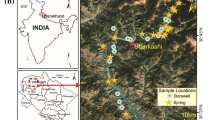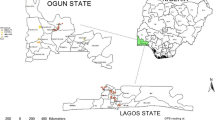Abstract
Understanding groundwater quality and hydrogeochemical behavior is important because consumption of the potentially toxic elements (PTEs)-contaminated drinking water may induce several health problems for humans and animals. In the current study, we examined the potential groundwater contamination with various PTEs (arsenic, As; cadmium, Cd; copper, Cu; manganese; Mn) and the PTEs-induced health risk. Groundwater (n = 111) was characterized for total As, Cd, Cu, and Mn concentrations and other water quality attributes along the River Sutlej floodplain of Punjab, Pakistan. Results revealed that groundwater, which is used for drinking purpose, contained high concentrations of As and Cd (mean As: 33 µg/L, mean Cd: 3 µg/L), exceeding 100% and 32% than the World Health Organization’s safe limits (10 and 3 µg/L, respectively) in drinking water. The other water quality attributes (i.e., EC, HCO3, Cl and SO4) were also found above their safe limits in most of the wells. Hydrogeochemical data showed that groundwater was dominated with Na–SO4, Na–Cl, Ca/Mg–CO3 type saline water. The hazard quotient and cancer risk indices values calculated for As and Cd indicated potential threat (carcinogenic risk > 0.0001 and non-carcinogenic risk > 1.0) of drinking groundwater in the study area. This study shows that the groundwater along River Sutlej floodplain poses a health threat to the communities relying on it for drinking and irrigation due to high concentrations of As and Cd in water. Moreover, it is important to monitor groundwater quality in the adjacent areas along River Sutlej floodplain and initiate suitable mitigation and remediation programs for the safety of people’s health in Punjab, Pakistan.
Graphic abstract




Similar content being viewed by others
References
Ahmad, A., & Bhattacharya, P. (2018). Arsenic contamination of groundwater in Indus River Basin of Pakistan. In A. Mukherjee (Ed.), Groundwater of South Asia. (pp. 393–403). Springer.
Ashraf, S., Rizvi, N. B., Rasool, A., Mahmud, T., Huang, G. G., & Zulfajri, M. (2020). Evaluation of heavy metal ions in the groundwater samples from selected automobile workshop areas in northern Pakistan. Groundwater for Sustainable Development, 11, 100428
Azizullah, A., Khattak, M. N. K., Richter, P., & Häder, D.-P. (2011). Water pollution in Pakistan and its impact on public health—A review. Environment International, 37, 479–497
Bradl, H. (2005). Sources and origins of heavy metals. Interface science and technology. (pp. 1–27). Elsevier.
Fatima, S., Hussain, I., Rasool, A., Xiao, T., & Farooqi, A. (2018). Comparison of two alluvial aquifers shows the probable role of river sediments on the release of arsenic in the groundwater of district Vehari, Punjab, Pakistan. Environmental Earth Sciences, 77, 382
Giosan, L., Clift, P. D., Macklin, M. G., Fuller, D. Q., Constantinescu, S., Durcan, J. A., Stevens, T., Duller, G. A. T., Tabrez, A. R., Gangal, K., Adhikari, R., Alizai, A., Filip, F., VanLaningham, S., & Syvitski, J. P. M. (2012). Fluvial landscapes of the Harappan civilization. Proceedings of the National Academy of Sciences of the United States of America, 109, E1688–E1694
Gleeson, T., Wada, Y., Bierkens, M. F., & van Beek, L. P. (2012). Water balance of global aquifers revealed by groundwater footprint. Nature, 488, 197–200
Jaishankar, M., Tseten, T., Anbalagan, N., Mathew, B. B., & Beeregowda, K. N. (2014). Toxicity, mechanism and health effects of some heavy metals. Interdisciplinary Toxicology, 7, 60–72
Jalees, M. I., Farooq, M. U., Anis, M., Hussain, G., Iqbal, A., & Saleem, S. (2020). Hydrochemistry modelling: Evaluation of groundwater quality deterioration due to anthropogenic activities in Lahore, Pakistan. Environment, Development and Sustainability, 23, 3062–3076
Khalid, S., Murtaza, B., Shaheen, I., Ahmad, I., Ullah, M. I., Abbas, T., Rehman, F., Ashraf, M. R., Khalid, S., Abbas, S., & Imran, M. (2018a). Assessment and public perception of drinking water quality and safety in district Vehari, Punjab, Pakistan. Journal of Cleaner Production, 181, 224–234
Khalid, S., Shahid, M., Natasha, Bibi, I., Sarwar, T., Shah, A., & Niazi, N. (2018b). A review of environmental contamination and health risk assessment of wastewater use for crop irrigation with a focus on low and high-income countries. International Journal of Environmental Research and Public Health, 15, 895–926
Khalid, S., Shahid, M., Natasha, Shah, A. H., Saeed, F., Ali, M., Qaisrani, S. A., & Dumat, C. (2020). Heavy metal contamination and exposure risk assessment via drinking groundwater in Vehari, Pakistan. Environmental Science and Pollution Research, 27, 39852–39864
Khalid, S., Shahid, M., Niazi, N. K., Rafiq, M., Bakhat, H. F., Imran, M., Abbas, T., Bibi, I., & Dumat, C. (2017). Arsenic behaviour in soil-plant system: Biogeochemical reactions and chemical speciation influences. In N. A. Anjum, S. S. Gill, & N. Tuteja (Eds.), Enhancing cleanup of environmental pollutants. (pp. 97–140). Springer, Cham.
Khan, A., Husain, V., & Bakhtiari, A. E. (2017). Groundwater arsenic contamination in semi-urban areas of Tando Muhammad Khan District: A case study from deltaic flood plain of Sindh, Pakistan. Sustainable Environment, 2, 171
Khan, S. N., Yasmeen, T., Riaz, M., Arif, M. S., Rizwan, M., Ali, S., Tariq, A., & Jessen, S. (2019). Spatio-temporal variations of shallow and deep well groundwater nitrate concentrations along the Indus River floodplain aquifer in Pakistan. Environmental Pollution, 253, 384–392
Murtaza, B., Amjad, M., Shahid, M., Imran, M., Shah, N. S., Abbas, G., & Naeem, M. A. (2019). Compositional and health risk assessment of drinking water from health facilities of District Vehari, Pakistan. Environmental Geochemistry and Health, 42, 2425–2437
Murtaza, B., Nazeer, H., Natasha, Amjad, M., Imran, M., Shahid, M., Shah, N. S., Farooq, A. B. U., Amjad, M., & Murtaza, G. (2020). Hydrogeochemical investigation of arsenic in drinking water of schools and age dependent risk assessment in Vehari District, Punjab Pakistan: A multivariate analysis. Environmental Science and Pollution Research, 27, 30530–30541
Natasha, Bibi, I., Shahid, M., Niazi, N. K., Younas, F., Naqvi, S. R., Shaheen, S. M., Imran, M., Wang, H., Hussaini, K. M., Zhang, H., & Rinklebe, J. (2021). Hydrogeochemical and health risk evaluation of arsenic in shallow and deep aquifers along the different floodplains of Punjab, Pakistan. Journal of Hazardous Materials, 402, 124074
Natasha, Shahid, M., Dumat, C., Khalid, S., Rabbani, F., Farooq, A. B. U., Amjad, M., Abbas, G., & Niazi, N. K. (2018). Foliar uptake of arsenic nanoparticles by spinach: An assessment of physiological and human health risk implications. Environmental Science and Pollution Research, 26, 20121–20131
Nations, U., Global issues: Water. http://www.un.org/en/sections/issues-depth/water/.
Niazi, N. K., Bibi, I., Shahid, M., Ok, Y. S., Burton, E. D., Wang, H., Shaheen, S. M., Rinklebe, J., & Lüttge, A. (2018). Arsenic removal by perilla leaf biochar in aqueous solutions and groundwater: An integrated spectroscopic and microscopic examination. Environmental Pollution, 232, 31–41
Niazi, N. K., Bibi, I., Shahid, M., Ok, Y. S., Shaheen, S. M., Rinklebe, J., Wang, H., Murtaza, B., Islam, E., Farrakh Nawaz, M., & Lüttge, A. (2017). Arsenic removal by Japanese oak wood biochar in aqueous solutions and well water: Investigating arsenic fate using integrated spectroscopic and microscopic techniques. Science of The Total Environment, 621, 1642–1651
PBS. (2017). Provisional summary results of 6th population and housing census-2017. http://www.pbs.gov.pk/content/provisional-summary-results-6th-population-and-housing-census-2017-0.
Pimentel, D., Berger, B., Filiberto, D., Newton, M., Wolfe, B., Karabinakis, E., Clark, S., Poon, E., Abbett, E., & Nandagopal, S. (2004). Water resources: Agricultural and environmental issues. BioScience, 54, 909–918
Polizzotto, M. L., Kocar, B. D., Benner, S. G., Sampson, M., & Fendorf, S. (2008). Near-surface wetland sediments as a source of arsenic release to ground water in Asia. Nature, 454, 505–508
Rahman, M. M., Naidu, R., & Bhattacharya, P. (2009). Arsenic contamination in groundwater in the Southeast Asia region. Environmental Geochemistry and Health, 31, 9–21
Rasool, A., Farooqi, A., Masood, S., & Hussain, K. (2016a). Arsenic in groundwater and its health risk assessment in drinking water of Mailsi, Punjab, Pakistan. Human and Ecological Risk Assessment: An International Journal, 22, 187–202
Rasool, A., Xiao, T., Farooqi, A., Shafeeque, M., Masood, S., Ali, S., Fahad, S., & Nasim, W. (2016b). Arsenic and heavy metal contaminations in the tube well water of Punjab, Pakistan and risk assessment: A case study. Ecological Engineering, 95, 90–100
Richards, L. (1954). Diagnosis and improvement of saline and alkali soil. United States Department of Agriculture, Handbook 60, Washington DC, USA.
Ryan, J., Estefan, G., & Rashid, A. (2007). Soil and plant analysis laboratory manual. ICARDA.
Shahid, M., Khalid, M., Dumat, C., Khalid, S., Niazi, N. K., Imran, M., Bibi, I., Ahmad, I., Hammad, H. M., & Tabassum, R. A. (2017a). Arsenic level and risk assessment of groundwater in Vehari, Punjab Province, Pakistan. Exposure and Health, 10, 229–239
Shahid, M., Niazi, N. K., Dumat, C., Naidu, R., Khalid, S., Rahman, M. M., & Bibi, I. (2018). A meta-analysis of the distribution, sources and health risks of arsenic-contaminated groundwater in Pakistan. Environmental Pollution, 242, 307–319
Shakoor, M. B., Bibi, I., Niazi, N. K., Shahid, M., Nawaz, M. F., Farooqi, A., Naidu, R., Rahman, M. M., Murtaza, G., & Lüttge, A. (2018). The evaluation of arsenic contamination potential, speciation and hydrogeochemical behaviour in aquifers of Punjab, Pakistan. Chemosphere, 199, 737–746
Shakoor, M. B., Niazi, N. K., Bibi, I., Murtaza, G., Kunhikrishnan, A., Seshadri, B., Shahid, M., Ali, S., Bolan, N. S., & Ok, Y. S. (2016). Remediation of arsenic-contaminated water using agricultural wastes as biosorbents. Critical Reviews in Environmental Science and Technology, 46, 467–499
Shakoor, M. B., Niazi, N. K., Bibi, I., Rahman, M. M., Naidu, R., Dong, Z., Shahid, M., & Arshad, M. (2015). Unraveling health risk and speciation of arsenic from groundwater in rural areas of Punjab, Pakistan. International Journal of Environmental Research and Public Health, 12, 12371–12390
Singh, C. K., Rina, K., Singh, R. P., & Mukherjee, S. (2014). Geochemical characterization and heavy metal contamination of groundwater in Satluj River Basin. Environmental Earth Sciences, 71, 201–216
Swarzenski, W. V. (1968). Fresh and saline ground-water zones in the Punjab region, West Pakistan. USGPO.
Tabassum, R. A., Shahid, M., Dumat, C., Niazi, N. K., Khalid, S., Shah, N. S., Imran, M., & Khalid, S. (2018). Health risk assessment of drinking arsenic-containing groundwater in Hasilpur, Pakistan: Effect of sampling area, depth, and source. Environmental Science and Pollution Research, 26, 20018–20029
UNEP. (2002). United Nations Environmental Program. Global water resources. UNEP vital water. Graphics: An overview of the state of the world’s fresh and marine waters.
US-EPA. (2005). Guidelines for carcinogen risk assessment; EPA/630/P-03/001F; Risk assessment forum: Washington, DC, USA.
USGS. (2016). United States geological survey. Where is earth’s water? The USGS Water Science School.
WHO. (2017). Guidelines for drinking-water quality: First addendum to the. (4th ed.). World Health Organization.
WHO. (2019). Progress on household drinking water, sanitation and hygiene 2000–2017: Special focus on inequalities. New York: United Nations Children’s Fund (UNICEF) and World Health Organization (WHO). World Health Organization
Acknowledgements
This research was supported by the COMSATS University Islamabad under CRGP/CIIT/VEH/17/1141. Dr Nabeel Khan Niazi is thankful to University of Agriculture Faisalabad and Higher Education Commission, Pakistan.
Author information
Authors and Affiliations
Corresponding authors
Ethics declarations
Conflict of interest
The authors declare that they have no conflict of interest.
Additional information
Publisher's Note
Springer Nature remains neutral with regard to jurisdictional claims in published maps and institutional affiliations.
Supplementary Information
Below is the link to the electronic supplementary material.
Rights and permissions
About this article
Cite this article
Ahmad, S., Imran, M., Murtaza, B. et al. Hydrogeochemical and health risk investigation of potentially toxic elements in groundwater along River Sutlej floodplain in Punjab, Pakistan. Environ Geochem Health 43, 5195–5209 (2021). https://doi.org/10.1007/s10653-021-00941-y
Received:
Accepted:
Published:
Issue Date:
DOI: https://doi.org/10.1007/s10653-021-00941-y




